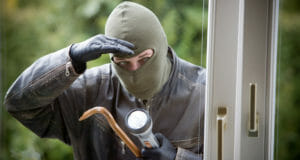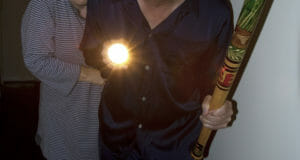|
Listen To The Article
|

Home Defense
When someone buys a gun for home defense, they tend to fall into one of three categories. These categories are based on the amount of thought an individual puts into their planning. Although you may find yourself falling in between two categories, these distinctions should help you see any improvements you can make in your home defense plan.
The first category—we’ll call it Category A—is an individual who buys his or her first home defense firearm. They buy a box of ammo and load the weapon; they then put it under the bed, in the nightstand, or in the gun safe. There really isn’t any more to their preparation. Yes, having a gun is better than throwing a rock, but honestly, at this level of planning, that’s about all you can say about it.
The next category, B, is the person buys their weapon, buys quite a few boxes of ammo, and becomes proficient with their weapon. They keep it loaded and in a safe, easy-to-access area. They maintain proficiency and are most likely considered to be a gun guy or gal. And while the level of defense is on a whole different plane than Category A, it can still be better.
The third and final category—you guessed, C—is the planner. They know having the weapon and being proficient in it is only a stepping-stone to proper home defense. This article will examine what seemingly everyone misses in home defense — planning.
Proper Weapon Selection
First off for the planner, is weapon selection. Proper weapon selection is based on a few important factors. You want to be able to bring enough gun to the fight without endangering others in the process. There are three main places people live. You have the cities and suburbs, and then you have the rural folks. Each of these areas is distinct and has its specific requirements.
City and Suburb Home Defense
When living in the city in place like townhouses and apartments, over penetration is a big deal. Defending yourself should never put your neighbors or family in danger. Something like a rifle or even some twelve-gauge shotgun rounds can present a danger inside an apartment. Older apartments and townhouses built from brick have a much lower chance for over penetration, but modern sheet rock is a different story. The same goes for houses in the suburbs; some suburban homes will be made from brick, while others could be made from vinyl siding or other thin materials. So what kind of weapon does a city or suburb dweller needs to protect their home?
When it comes to over penetration, experiments have been conducted over and over, and all serious defensive rounds penetrate drywall and sheet rock. Even twelve-gauge number four penetrates walls. So what does this teach us? First those city and suburban folk have to learn to be a darn good shot. Second, round selection is critical. Reduced-recoil shotgun rounds, the kind favored by police, have a perfect place here. They are still potent man stoppers, perhaps even more so than their full-powered counterparts, but the best part about these rounds is that the reduced recoil means reduced penetration on walls and bad guys. The pellets are much less likely to go through the bad guy and continue on into the walls behind him. Should you miss, these rounds will lose a lot of velocity fast, especially after going through a wall.
Handgun rounds like the .45 ACP and 9mm are also well suited. By nature, handgun rounds never travel as far as rifle rounds. Special rounds like the Mag Safe SWAT round are excellent choices. These rounds are pre-fragmented to aid in breaking apart and not penetrating through the bad guy. I suggest these rounds to anyone who wants to defend their home with a handgun. I would go as far as to say that this is the best compromise of power and safety one can use.
Rural Home Defense
Rural folks have it much easier to defend their homes. When the homes are anywhere from hundreds of yards to miles apart, your selection opens up a bit. Over penetration inside the home is still a concern, however. Putting your family at risk is counter intuitive to self-defense. The rural defender has the advantage of knowing if anything is at risk behind the bad guy; he has a lot less to worry about. The same standard of shotgun and handgun still applies here, as both are excellent choice. A rural resident also has the option of using a rifle if they know their family is secure. In a home with no children, the rural defender knows the only other resident is his wife and most likely knows exactly where they are.
A rural resident should still own a rifle if they have chosen a shotgun or pistol for home defense. In a rural area, you have a much better chance to encounter feral, rabid, or aggressive animals. The ability to engage a wild and dangerous animal at long range is a much safer alternative. Men and women living on the border also have to deal with the potential for dangerous illegal aliens, including criminals and drug smugglers. The ability to be properly armed to engage these threats is critical.
Beyond the Weapon
Weapon selection plays an incredibly critical role in home defense, but it isn’t everything. Planning beyond the weapon is a key to success. The first step is proficiency with your weapon. Seeking out proper instruction and training is important. Simple weapons familiarization and target practice can save the day. All the fancy mag changes and shooting stances don’t mean diddly if you can’t hit your target or know how to apply proper remedial action.
Next is making sure your partner is proficient your firearms or their own. My wife dislikes my twelve-gauge pump shotgun; its recoil is too heavy, and she’s never been comfortable with it. She’s a dead shot with her .38 special though.
Next piece of equipment is a good flashlight. I have a weapon-mounted flashlight on my shotgun, and my wife has her ultra-bright Side Winder flashlight. Her flashlight has multiple settings, one white light, one red light, and one blue light. Light discipline is also important; specifically, learning when to use your flashlight should be part of your training. It should be used when you know you can’t see anything in the next room, and the room is very likely to house the predator. A flashlight turned on too early will reveal your position.
A piece of equipment you may have never thought about is a good pair of ear protection. Firing a weapon indoors is ridiculously loud. In Afghanistan I suffered permanent loss of hearing from firing a machine gun inside a building. There are expensive electronic ear protectors that amplify noises below a certain decibel point and mute noises louder than a certain decibel point. These would probably be the best to have, but they are expensive. My wife and I both have an inexpensive eight-dollar set we bought to double as both our range and home defense ears.
Next is something to carry your ammunition. At night I tend to sleep in a pair of basketball shorts and a shirt. My wife is in pajama pants and a shirt as well—not exactly the best tactical wear. She luckily has pockets she can put a couple of speed loaders in, but I prefer a bandolier belt for shotgun ammunition. It carries twenty-five rounds and cost five bucks.
The Plan
We have the gear and we have the guns; now we need to use the most effective weapons we have, and it’s contained in the six inches between your ears. It shouldn’t just be your plan; it’s your family’s plan. Each plan will have to be different to meet different needs, to accommodate different size families and homes. A plan should be simple and known by everyone in your home. Your plan should not be to clear your home and engage the intruder. Your plan should be to get you and your family to a safe location.
My family’s plan is simple. In the event an intruder is in our home, we grab our weapons, our ear protection, and extra ammunition. Next, my wife and I quietly and carefully move to our son’s room. I cover down the hallway as she grabs our son from his bed. We again quietly move back to our bedroom, while she carries our son and I provide the security.
Once we are back in our room, she takes our son to the master bathroom, which is only accessible through our room. On the way, she takes her cell phone and calls the police. I cover the door at an offset angle with my shotgun, and we wait until the police arrive.
This is our plan for a nighttime break in. In the case of a home invasion, we have a different plan that is still very similar. My wife gets our son, and I cover her. If possible, we retreat to a safe location and call the police.
These are my views on home defense, the equipment I prefer, and some examples of my family’s plan. While you may have different preferences, it doesn’t change the fact that you need to take planning seriously. Owning a gun is simply not enough. Engage the weapon between your eyes, and your chances of safely defending your family will increase tenfold.
 Off The Grid News Better Ideas For Off The Grid Living
Off The Grid News Better Ideas For Off The Grid Living




